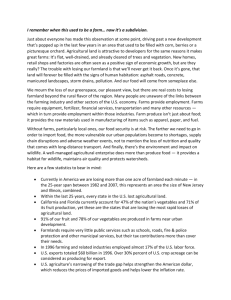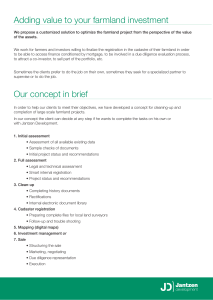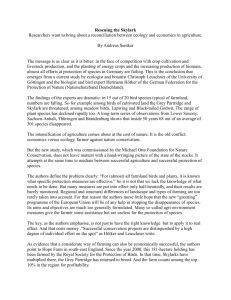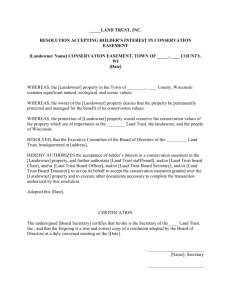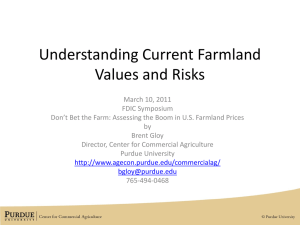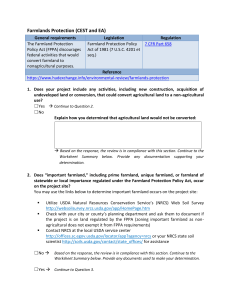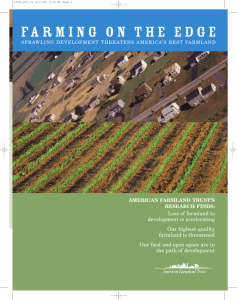Growth Management Strategies - South Carolina Sea Grant
advertisement
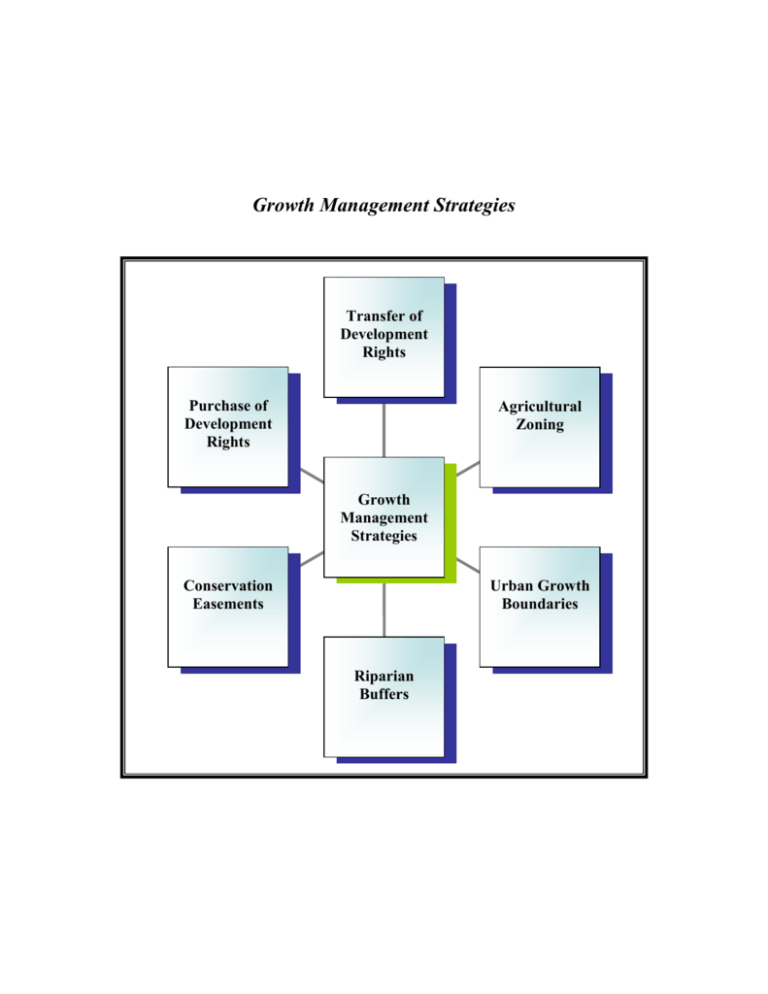
Growth Management Strategies Transfer of Development Rights Purchase of Development Rights Agricultural Zoning Growth Management Strategies Conservation Easements Urban Growth Boundaries Riparian Buffers Conservation Easements Conservation easements have been proven to be a valuable tool to preserve and protect South Carolina while maintaining the tradition of local control and private ownership. An easement is a voluntary agreement between a landowner and a certified non-profit that allows the landowner to protect his or her property from inappropriate development or alteration. A conservation easement is a legal agreement restricting the development of a piece of property, such that the landowner is donating the right to develop or subdivide their property. The agreement is flexible, can cover all or part of the property, and can be tailored to meet the personal and financial interests of the individual. Conservation agreements provide many benefits to a community, including the protection of water quality and natural habitat, preservation of open space, outdoor recreation and educational opportunities, increased property values on adjacent land, and decreased costs of drinking water treatment. The benefits to the landowner include the assurance that land will be protected for future generations while remaining in private hands, possible federal and state income tax deductions, and possible decreased property and estate taxes. Purchase of Development Rights (PDR) South Carolina communities have utilized federal, state, local, and private PDR programs to protect important natural resources such as farmland and wetlands. Under a PDR program, a landowner voluntarily sells the rights of development on his/her property to a government agency or community organization. The land owner retains ownership, while permanently protecting the land from certain types of development. The price of the development rights is determined by the difference between the value of the land if developed and the value of the land held as open space. A PDR program benefits local communities by discouraging sprawling development, preserving open space, and creating affordable farmland. Transfer of Development Rights (TDR) Transfer of development rights (TDR) programs, a mechanism for directing growth and development in community; have been used successfully in protecting agricultural and ecologically sensitive lands in South Carolina. A TDR program directs land development toward a desired growth area in a community by providing a market whereby rural landowners can sell their right to convert their properties to high-density developments. A TDR program can benefit a community by reducing infrastructure cost, creating permanently protected farmland, increasing recreational opportunities, protecting natural habitats, and preserve historic and scenic resources. Agricultural Zoning Districts Agricultural zoning generally establishes districts with very large minimum lot size requirements in order to strictly limit development in areas where preservation of farmland and rural character is desired. Agricultural districts are particularly useful in targeting agricultural land use to prime farm lands and away from urban and residential developments. Agricultural zoning districts can benefit a community by preventing farmland from being converted to nonfarm uses, minimizing the fragmentation of farms, preventing land-use conflicts, and reducing farmland costs. Urban Growth Boundaries (UGB) Urban growth boundaries (UGB), legal boundaries separating urban land from rural land, have been adopted by many coastal cities and counties in their efforts to curb sprawl and protect open space. The UGB defines the extent of future growth within a community by establishing a boundary within which urban types of development will be permitted, and restricting development outside the boundary to preserve farmland and the rural character of the areas lying outside the boundary. By specifying areas where local governments will provide future urban services, such as water supply or sewage treatment, UGB’s can promoting more efficient use of land. An UGB can further benefit a community by protecting farmland and forested lands, preserving natural areas and habitats, and retaining rural character and quality of life. Riparian Buffer Riparian buffer ordinances with various types and size requirements have been implemented in South Carolina to prevent development in environmentally sensitive areas. Riparian buffers are areas of land along rivers and streams that help maintain clean water and healthy aquatic life, when left undisturbed. They create corridors of vegetation along rivers, streams, and tidal wetlands that provide protective transitional zones between upland development and adjoining surface waters. Buffers are beneficial to a community by providing important natural habitats; reducing impacts of flood, drought, and erosion; creating recreation and education opportunities, and improving water. Growth Management Informational Sources I. Sources for General Information SC Sea Grant Nemo: www.scseagrant.org/scnemo.htm Urban Land Institute: www.uli.org Low Impact Developmen Centert: www.lowimpactdevelopment.org Center for Watershed Protection: www.cwp.org Trust for Public Land: www.tpl.org Lowcountry Open Land Trust: www.lolt.org Palmetto Conservation Foundation: www.palmettoconservation.org Ducks Unlimited: http://southern.ducks.org/Southcarolinaconservation.php The Nature Conservancy: http://nature.org/wherewework/northamerica/states/southcarolina/ Beaufort County Open Land Trust: www.openlandtrust.com SCDHEC: www.scdhec.gov SCHEC-OCRM: www.scdhec.net/ocrm/ Clemson Extension: http://www.clemson.edu II. Sources for Funding Opportunities American Farmland Trust: www.farmland.org Clean Water Action: www.cleanwateraction.org Coalition for Smart Growth: www.samrtgrowth.net Land Trust Alliance: www.lta.org National Environmental Trust: www.environet.policy.net/cleanair SC Environmental Excellence Program: www.iopa.sc.edu/sceep/ US Environmental Protection Agency: www.epa.gov SC Conservation Bank: www.palmettoconservation.org Coastal Services Center Cooperative Agreements (NOAA): http://www.csc.noaa.gov/ Empowerment Zones Program (USDA/Office of Community Development): http://www.hud.gov/offices/cpd/ezec/index.cfm Land and Water Conservation Fund Grants to States (DOI): http://www.ncrc.nps.gov/lwcf/ The Conservation Fund: www.conservationfund.org Bring Back the Natives Grant Program (NFWF): http://www.nfwf.org/_ Farmland Protection Program (USDA): http://www.nrcs.usda.gov Coastal Program (DOI/USFWS): http://www.fws.gov/cep/cepcode.html Partners for Fish and Wildlife Habitat Restoration Program (DOI/USFWS): http://www.fws.gov/cep/coastweb.html Nonpoint Source Implementation Grants-Section 319 (EPA/OWOW): http://www.epa.gov/owow/nps/ Water Quality Cooperative Agreements (EPA Region 4): http://www.epa.gov/owm/wm042000.htm Wetlands Reserve Program (USDA): http://www.wl.fb-net.org Rural Development, Forestry, and Communities (USDA/Forest Service): http://www.fs.fed.us/spf/coop/eap.htm

